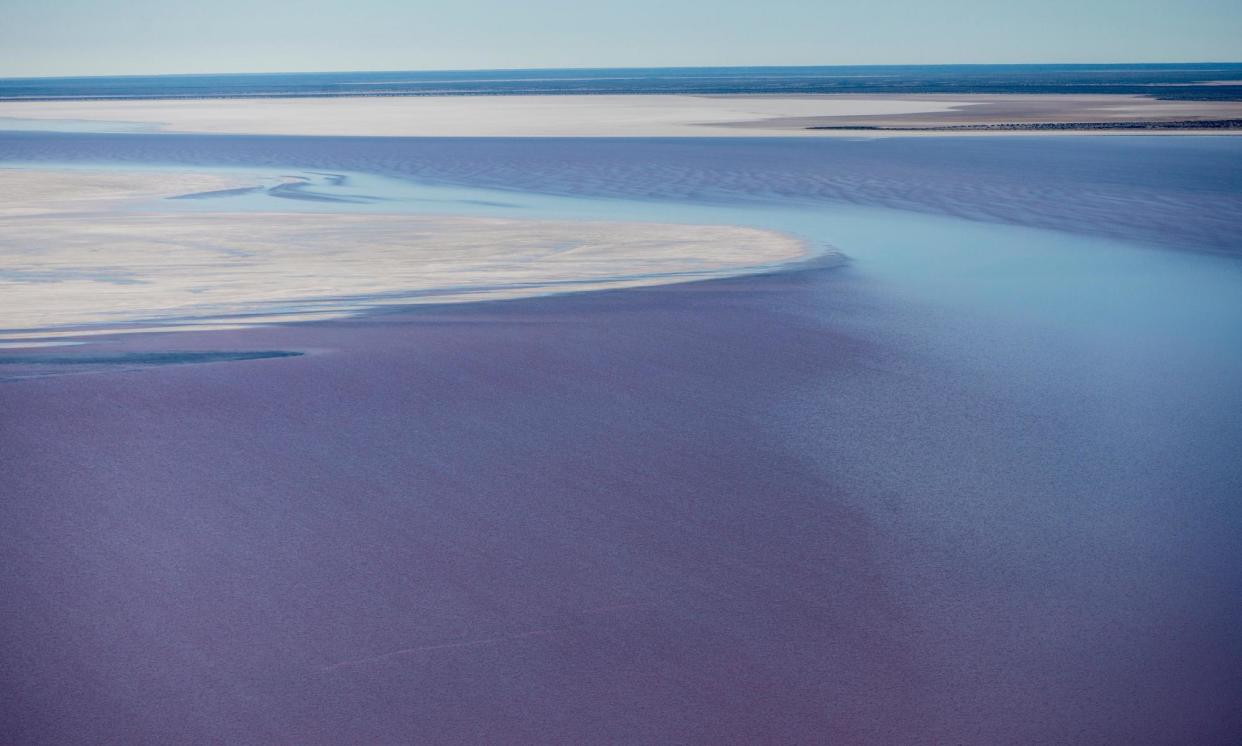At ‘vast, remote’ Kati Thanda-Lake Eyre, unwritten rules for tourists may soon become real restrictions

When Bronwyn Dodd looks out across Kati Thanda-Lake Eyre, an expanse covering almost 1,000 sq km in the middle of a national park, she thinks of home.
It’s a place both sacred and dangerous, she says, which is why there’s a plan to stop people walking on the lake bed without permission.
“I think of the place my father, my grandparents and all those that came before have walked, dived, hunted, survived,” the chair of the Arabana Aboriginal Corporation says.
“In such a vast, remote landscape it’s very grounding to think our people have survived there for thousands of years.
“I also reflect on water. Water is very sacred to us. My elders often tell me: ‘without water, there is no life’.”
Kati Thanda-Lake Eyre, about 700km north of Adelaide, is an enormous salt pan – until the floods creep through it, bringing colour and life.
There’s a small flood every few years, a big one once a decade, and the lake fills up about once every 25 years as water from the Lake Eyre Basin – which spreads across Queensland, the Northern Territory, New South Wales and South Australia – drains into it.
Overlaying it are the Arabana’s dreaming stories, their knowledge, their songs and traditions – their Ularaka. There are culturally significant mound springs, dreaming stories associated with the underlying Great Artesian Basin. There are totemic species, alongside bush tucker and traditional medicines.
But the lake also attracts tourists, who sometimes stray from the paths in their cars or by foot. A draft management plan aims to stop that, and to keep tourists to specific viewing platforms and on specific tracks around the lake bed. There’ll be exemptions for scientific research and commercial filming and photography.
Swimming, driving and boating are already restricted. Those restrictions will be extended to walking on the lake bed if the plan goes ahead.
“It’s actually quite dangerous for them to [walk on the lake bed],” Dodd says.
“You can sink knee-deep in it.”
The notion has brought a predictable reaction from some who compare it to the ban on climbing Uluru, or Mount Warning in NSW and foment fear about non-Indigenous exclusion.
Local publican and tourism operator Trevor Wright says there’s no comparison.
For a start, he says, the ban will have no effect on tourists at all.
“Zero,” he says.
“It’s been an unwritten rule for the last 20 years that you don’t go out on the lake – you don’t go boating. It’s very shallow, and huge, and with winds you could end up anywhere.”
And you wouldn’t go swimming once the floods come.
“That lake is 12.5 times saltier than seawater and two-and-a-half times saltier than the Dead Sea. It’ll burn the hell out of your membranes. And under the salt crust there’s black slimy clay that utterly stinks and is full of crystallised gypsum, like glass – it’ll cut your legs open.”
“And people think they can drive on it … You go and pull a vehicle out of there. It’s a big job.”
Never mind getting lost.
Wright says the views of the shimmering salt pan or the flood-driven transformation are best from the shoreline or from the air, and that he hopes there’ll be better infrastructure and signage to help tourists get there.
Dodd agrees there’s “nothing new”, just a strengthening of the existing rules to stop people tramping on sacred ground and walking into trouble.
“We want to share our country with the world. We’re just asking people to protect it,” she says. The land was entrusted to the Arabana, and they have a responsibility to both protect it and educate people about it.
“It’s not about locking people out,” she says.
“We’re definitely not banning people. Just stick to the tracks that have been there for a very long time.”
On top of the cultural considerations, the area is home to rare species, including the black-breasted buzzard and the yellow-bellied sheath-tailed bat. The Lake Eyre dragon is one of a number of endemic vertebrates, and when those waters come through, the floods are a major breeding event for birds.
Northern Territory senator and indigenous affairs shadow minister, Jacinta Nampijinpa Price, was asked about the situation along with other restrictions on access including at Uluru and Mount Warning in NSW.
“We’re locking the place up,” she told 2GB’s Ben Fordham. Indigenous culture had “almost become the new religion”, she said.
SA opposition leader, David Speirs, said if the changes were “to protect biodiversity or people’s safety” he would accept the changes easily, but was scathing about doing it for the Arabana people.
“I don’t like seeing mythology and superstition blended with science … if there’s any area where there are songlines or particular stories and lore from Aboriginal people that will be impacted by visitors, I would have to have a significant level of confidence that was the case before seeing the community locked out of places,” he said.
Consultation on the plan is open till 19 July.
The state’s water and environment minister, Susan Close, says visitors can still enjoy the park and the views from the air or designated visitor areas.
“The proposal for visitors not to enter a sacred cultural site is made both in recognition and respect for Arabana culture, and to ensure the safety of visitors,” she says.
“The Australian desert environment is extremely harsh, particularly on the white salt lake where it’s easy to lose your sense of direction and get lost.”
Dodd is disappointed at false claims that people will be banned from the park or from visiting the lake.
“We’d love to have more people out there, to share our culture and have more hands-on experiences,” she says.
“You don’t have to walk on the lake to get that.”


